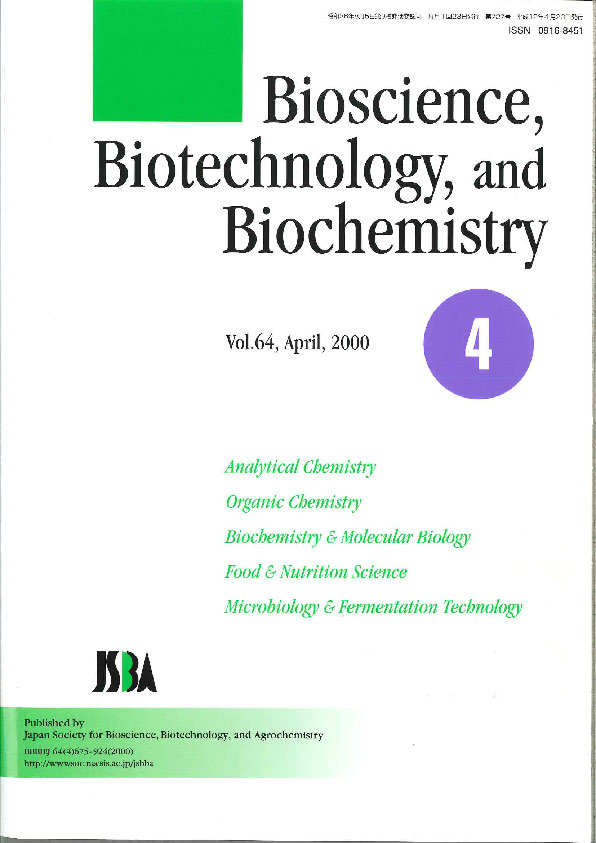64 巻, 4 号
選択された号の論文の46件中1~46を表示しています
- |<
- <
- 1
- >
- >|
Review
-
2000 年64 巻4 号 p. 675-688
発行日: 2000年
公開日: 2005/03/01
PDF形式でダウンロード (3515K)
Organic Chemistry Regular Papers
-
2000 年64 巻4 号 p. 702-709
発行日: 2000年
公開日: 2005/03/01
PDF形式でダウンロード (1101K) -
2000 年64 巻4 号 p. 808-815
発行日: 2000年
公開日: 2005/03/01
PDF形式でダウンロード (1351K)
Organic Chemistry Notes
-
2000 年64 巻4 号 p. 858-861
発行日: 2000年
公開日: 2005/03/01
PDF形式でダウンロード (784K) -
2000 年64 巻4 号 p. 869-872
発行日: 2000年
公開日: 2005/03/01
PDF形式でダウンロード (880K) -
2000 年64 巻4 号 p. 873-874
発行日: 2000年
公開日: 2005/03/01
PDF形式でダウンロード (468K) -
2000 年64 巻4 号 p. 875-877
発行日: 2000年
公開日: 2005/03/01
PDF形式でダウンロード (741K) -
2000 年64 巻4 号 p. 878-881
発行日: 2000年
公開日: 2005/03/01
PDF形式でダウンロード (752K) -
2000 年64 巻4 号 p. 882-886
発行日: 2000年
公開日: 2005/03/01
PDF形式でダウンロード (1059K) -
2000 年64 巻4 号 p. 894-898
発行日: 2000年
公開日: 2005/03/01
PDF形式でダウンロード (830K) -
2000 年64 巻4 号 p. 907-910
発行日: 2000年
公開日: 2005/03/01
PDF形式でダウンロード (826K)
Biochemistry & Molecular Biology Regular Papers
-
2000 年64 巻4 号 p. 689-695
発行日: 2000年
公開日: 2005/03/01
PDF形式でダウンロード (1558K) -
2000 年64 巻4 号 p. 710-716
発行日: 2000年
公開日: 2005/03/01
PDF形式でダウンロード (1056K) -
2000 年64 巻4 号 p. 717-722
発行日: 2000年
公開日: 2005/03/01
PDF形式でダウンロード (1534K) -
2000 年64 巻4 号 p. 723-730
発行日: 2000年
公開日: 2005/03/01
PDF形式でダウンロード (4628K) -
2000 年64 巻4 号 p. 731-734
発行日: 2000年
公開日: 2005/03/01
PDF形式でダウンロード (892K) -
2000 年64 巻4 号 p. 735-740
発行日: 2000年
公開日: 2005/03/01
PDF形式でダウンロード (1433K) -
2000 年64 巻4 号 p. 741-745
発行日: 2000年
公開日: 2005/03/01
PDF形式でダウンロード (1348K) -
2000 年64 巻4 号 p. 767-774
発行日: 2000年
公開日: 2005/03/01
PDF形式でダウンロード (1191K) -
2000 年64 巻4 号 p. 775-780
発行日: 2000年
公開日: 2005/03/01
PDF形式でダウンロード (2310K) -
2000 年64 巻4 号 p. 781-784
発行日: 2000年
公開日: 2005/03/01
PDF形式でダウンロード (848K) -
2000 年64 巻4 号 p. 785-792
発行日: 2000年
公開日: 2005/03/01
PDF形式でダウンロード (1478K) -
2000 年64 巻4 号 p. 799-807
発行日: 2000年
公開日: 2005/03/01
PDF形式でダウンロード (2805K) -
2000 年64 巻4 号 p. 816-827
発行日: 2000年
公開日: 2005/03/01
PDF形式でダウンロード (2735K) -
2000 年64 巻4 号 p. 828-832
発行日: 2000年
公開日: 2005/03/01
PDF形式でダウンロード (1439K)
Biochemistry & Molecular Biology Notes
-
2000 年64 巻4 号 p. 845-847
発行日: 2000年
公開日: 2005/03/01
PDF形式でダウンロード (1147K) -
2000 年64 巻4 号 p. 862-864
発行日: 2000年
公開日: 2005/03/01
PDF形式でダウンロード (571K) -
Identification of L-Inositol and Scyllitol and Their Distribution in Various Organs in Chrysanthemum2000 年64 巻4 号 p. 865-868
発行日: 2000年
公開日: 2005/03/01
PDF形式でダウンロード (910K) -
2000 年64 巻4 号 p. 887-890
発行日: 2000年
公開日: 2005/03/01
PDF形式でダウンロード (1207K) -
2000 年64 巻4 号 p. 899-902
発行日: 2000年
公開日: 2005/03/01
PDF形式でダウンロード (949K) -
2000 年64 巻4 号 p. 903-906
発行日: 2000年
公開日: 2005/03/01
PDF形式でダウンロード (1107K) -
2000 年64 巻4 号 p. 911-914
発行日: 2000年
公開日: 2005/03/01
PDF形式でダウンロード (957K) -
2000 年64 巻4 号 p. 915-918
発行日: 2000年
公開日: 2005/03/01
PDF形式でダウンロード (902K) -
2000 年64 巻4 号 p. 919-923
発行日: 2000年
公開日: 2005/03/01
PDF形式でダウンロード (1355K)
Food & Nutrition Science Regular Papers
-
2000 年64 巻4 号 p. 696-701
発行日: 2000年
公開日: 2005/03/01
PDF形式でダウンロード (1109K) -
2000 年64 巻4 号 p. 793-798
発行日: 2000年
公開日: 2005/03/01
PDF形式でダウンロード (1401K)
Food & Nutrition Science Notes
-
2000 年64 巻4 号 p. 837-840
発行日: 2000年
公開日: 2005/03/01
PDF形式でダウンロード (964K) -
2000 年64 巻4 号 p. 848-851
発行日: 2000年
公開日: 2005/03/01
PDF形式でダウンロード (983K) -
2000 年64 巻4 号 p. 891-893
発行日: 2000年
公開日: 2005/03/01
PDF形式でダウンロード (977K)
Microbiology & Fermentation Technology Regular Papers
-
2000 年64 巻4 号 p. 746-750
発行日: 2000年
公開日: 2005/03/01
PDF形式でダウンロード (1255K) -
2000 年64 巻4 号 p. 751-756
発行日: 2000年
公開日: 2005/03/01
PDF形式でダウンロード (1384K) -
2000 年64 巻4 号 p. 757-760
発行日: 2000年
公開日: 2005/03/01
PDF形式でダウンロード (774K) -
2000 年64 巻4 号 p. 761-766
発行日: 2000年
公開日: 2005/03/01
PDF形式でダウンロード (1487K)
Microbiology & Fermentation Technology Notes
-
2000 年64 巻4 号 p. 833-836
発行日: 2000年
公開日: 2005/03/01
PDF形式でダウンロード (817K) -
2000 年64 巻4 号 p. 841-844
発行日: 2000年
公開日: 2005/03/01
PDF形式でダウンロード (715K) -
2000 年64 巻4 号 p. 852-857
発行日: 2000年
公開日: 2005/03/01
PDF形式でダウンロード (1227K)
- |<
- <
- 1
- >
- >|
